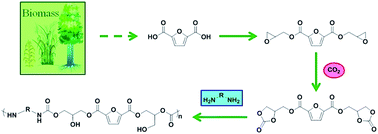A novel 2,5-furandicarboxylic acid-based bis(cyclic carbonate) for the synthesis of biobased non-isocyanate polyurethanes†
Abstract
This paper describes the synthesis of a new biobased bis(cyclic carbonate) derived from 2,5-furandicarboxylic acid (FDCA) with the incorporation of CO2. The bis(cyclic carbonate) was then used to synthesize non-isocyanate polyurethanes (NIPUs) via polyaddition reactions with a series of diamines. The chemical structures of the bis(cyclic carbonate) and the NIPUs were characterized by Fourier transform infrared spectroscopy (FT-IR) and proton nuclear magnetic resonance spectroscopy (1H NMR). The number-average molecular weights (Mn) of the NIPUs were between 3900 g mol−1 and 7000 g mol−1 as determined by gel permeation chromatography (GPC). The thermal properties of the NIPUs were investigated by differential scanning calorimetry (DSC) and thermogravimetric analyses (TGA). The results showed that the NIPUs synthesized in this study had a degradation temperature for 5% weight loss (T5%) in the range of 240 °C and 279 °C, indicating good thermal stability. The NIPUs were also found to be fully amorphous with a broad range of glass transition temperatures (Tg) from 63 °C to 113 °C, depending on the chemical structures of the diamines used. The rigid chemical moiety of cycloaliphatic diamine led to a higher Tg of the NIPUs than the flexible carbon chains of linear aliphatic diamines. This study demonstrated a new method for the synthesis of biobased NIPUs, with satisfactory properties, from FDCA, which is an important platform chemical derived from cellulosic biomass.



 Please wait while we load your content...
Please wait while we load your content...